An analysis by The New York Times compares current and cumulative COVID deaths in the U.S. to other large, wealthy countries. Data analyzed include vaccination, age and obesity levels, and public trust, all factors that influence outcomes.

The analysis opens with two graphs showing COVID death rates for countries with the highest gross national income per capita that have more than 10 million people. The U.S. is the highest in both graphs: cumulative deaths from Jan. 22, 2020, to Jan. 31, 2022, and during the Omicron wave, from Dec. 1, 2021 to Jan. 31, 2022.
Cumulative deaths in the U.S. passed the 900,000 milestone on Feb. 4. The next highest is Brazil with 633,00 and India with 504,000, according to the Times coronavirus global tracker on Feb. 8.
"In recent months, the United States passed Britain and Belgium to have, among rich nations, the largest share of its population to have died from Covid over the entire pandemic," write Benjamin Mueller, a health and science reporter for The New York Times and Eleanor Lutz, an information designer working at the Times' graphics desk, on Feb. 1.
The second graph shows U.S. deaths during the Omicron wave, starting on December 1 when the first case resulting from the Omicron variant was identified in San Francisco. It is more sobering as the U.S. stands far apart from any of its counterparts in the share of its population succumbing to the virus.
Since Dec. 1, when health officials announced the first Omicron case in the United States, the share of Americans who have been killed by the coronavirus is at least 63 percent higher than in any of these other large, wealthy nations, according to a New York Times analysis of mortality figures.
Experts noted the contrast in outcomes with other developed nations.
“The U.S. stands out as having a relatively high fatality rate,” said Joseph Dieleman, an associate professor at the University of Washington who has compared Covid outcomes globally. “There’s been more loss than anyone wanted or anticipated.”
“Death rates are so high in the States — eye-wateringly high,” said Devi Sridhar, head of the global public health program at the University of Edinburgh in Scotland, who has supported loosening coronavirus rules in parts of Britain. “The United States is lagging.”
U.S. death rate: 15th highest in world
The U.S. is averaging almost 2,600 daily deaths from COVID, an increase of 25% during the last two weeks, according to the Times U.S. tracker on Feb. 8. Next highest is India with 1,117 followed by Brazil with 765, according to the Times global tracker.
The world's highest daily average death rate belongs to Bosnia and Herzegovina: 1.53 per 100,000 people. The U.S. is fifteenth on the tracker, with 0.78 per 100k. When considering only nations with >10 million people, as the Times analysis did, only Greece is higher, averaging 0.95 deaths per 100,000 people in the last week.
Delta still takes its toll
Omicron is not entirely to blame as the "Delta surge that had already sent Covid deaths climbing by early December, putting the United States in a more precarious position than many European countries," add Mueller and Lutz. "Even in recent weeks, some American deaths likely resulted from lengthy illnesses caused by Delta."
Vaccinations and hospitalizations
The U.S. is not experiencing the Omicron wave like many of its Western European counterparts, which are recording even greater infections despite their larger share of vaccinated population. But hospitalizations, and subsequently deaths, are more manageable than in the U.S.
Chief among the reasons is the country’s faltering effort to vaccinate its most vulnerable people at the levels achieved by more successful European countries.
Twelve percent of Americans 65 and over [are not fully vaccinated] and 43 percent of people 65 and over have not received a booster shot. Even among the fully vaccinated, the lack of a booster leaves tens of millions with waning protection, some of them many months past the peak levels of immunity afforded by their second shots.
In England, by contrast, only 4 percent of people 65 and over have not been fully vaccinated and only 9 percent do not have a booster shot.
Other risk factors
The top graph in the Risk Factors for Severe Covid-19 section is "Share of population not fully vaccinated," with the U.S. at the top and Canada and Australia at the bottom.
In "Share of population age 65 and older," Japan is on top, with the U.S. and Australia at the bottom. However, if the share is relatively smaller bu less vaccinated, it is less beneficial.
Finally, the U.S. tops the "Share of adult population with obesity" with 36%. Japan is at the bottom with only 4%! The Netherlands is next with 20%.
Distrust in government
Not all problems are physical or demographic.
More Americans have also come to express distrust — of the government, and of each other — in recent decades, making them less inclined to follow public health precautions like getting vaccinated or reducing their contacts during surges, said Thomas Bollyky, director of the global health program at the Council on Foreign Relations.
A study published in the scientific journal The Lancet on Tuesday [Feb. 1] by Mr. Bollyky and Dr. Dieleman of the University of Washington found that a given country’s level of distrust had strong associations with its coronavirus infection rate.
PBS coverage of The New York Times analysis
Geoff Bennett of the PBS NewsHour "looks at why the nation is struggling compared to much of the world," discussing the Times' findings with Jennifer Nuzzo, who studies epidemiology and global health at the Johns Hopkins Center For Health Security.
"[F]irst of all, we have to acknowledge that it's a complete and utter tragedy because the vast majority of the deaths have been preventable, because many of them have occurred, in fact, most of them have occurred since the development of the COVID-19 vaccines," stated Nuzzo at the beginning of the 7-minute interview (video and transcript available).
Bennett asked how does "the politicization of the public health response in this country stack up with our industrialized peer nations?" Nuzzo pointed to the aforementioned Lancet study that found that "public trust" was "probably the single biggest predictor of how countries have performed in terms of COVID outcomes."
And, unfortunately, when political leaders make a political issue out of simple biology, which is that the virus is deadly and the vaccines protect people, it unfortunately deters people from getting vaccinated.
Testing and masks
"While infection levels remain high in many states, scientists said that some deaths could still be averted by people taking precautions around older and more vulnerable Americans, like testing themselves and wearing masks," add Mueller and Lutz of the Times.
Nuzzo told Bennet that when it comes to testing and masking, it was important for the government to subsidize their costs and ensure their accessibility as is done in many European and Asian countries. [See related post: "The Great American COVID Testing Failure," December 28, 2021]
Normalizing deaths
"The toll from future waves will depend on what other variants emerge, scientists said, as well as what level of death Americans decide is tolerable," add Mueller and Lutz
“We’ve normalized a very high death toll in the U.S.,” said Anne Sosin, who studies health equity at Dartmouth. “If we want to declare the end of the pandemic right now, what we’re doing is normalizing a very high rate of death.”
Related in Planetizen:
FULL STORY: U.S. Has Far Higher Covid Death Rate Than Other Wealthy Countries

Planetizen Federal Action Tracker
A weekly monitor of how Trump’s orders and actions are impacting planners and planning in America.

Maui's Vacation Rental Debate Turns Ugly
Verbal attacks, misinformation campaigns and fistfights plague a high-stakes debate to convert thousands of vacation rentals into long-term housing.

San Francisco Suspends Traffic Calming Amidst Record Deaths
Citing “a challenging fiscal landscape,” the city will cease the program on the heels of 42 traffic deaths, including 24 pedestrians.

Amtrak Rolls Out New Orleans to Alabama “Mardi Gras” Train
The new service will operate morning and evening departures between Mobile and New Orleans.

The Subversive Car-Free Guide to Trump's Great American Road Trip
Car-free ways to access Chicagoland’s best tourist attractions.

San Antonio and Austin are Fusing Into one Massive Megaregion
The region spanning the two central Texas cities is growing fast, posing challenges for local infrastructure and water supplies.
Urban Design for Planners 1: Software Tools
This six-course series explores essential urban design concepts using open source software and equips planners with the tools they need to participate fully in the urban design process.
Planning for Universal Design
Learn the tools for implementing Universal Design in planning regulations.
Heyer Gruel & Associates PA
JM Goldson LLC
Custer County Colorado
City of Camden Redevelopment Agency
City of Astoria
Transportation Research & Education Center (TREC) at Portland State University
Jefferson Parish Government
Camden Redevelopment Agency
City of Claremont





























